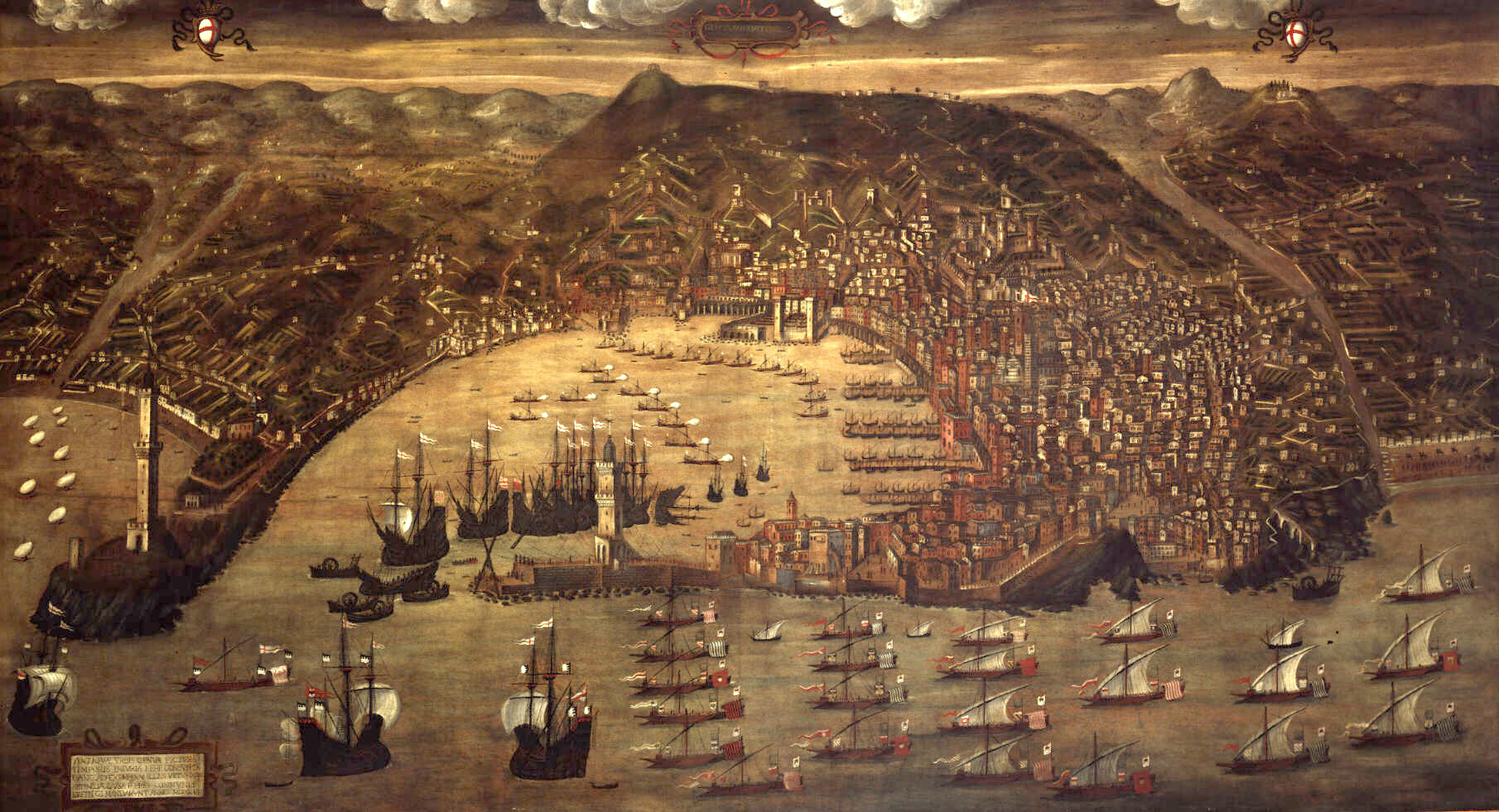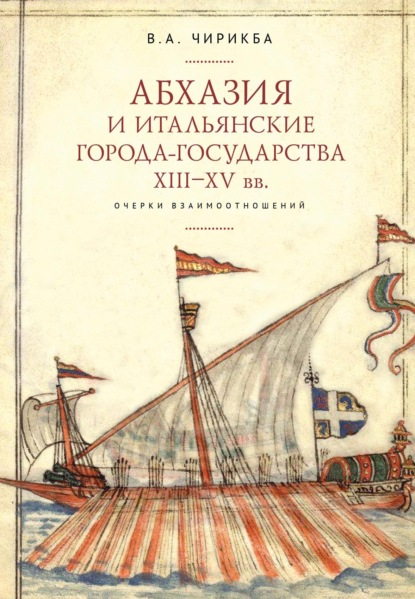The Italian maritime republics and slave trade from the Caucasus Areas Abkhazia

View of di Genoa in the 1481 (Cristoforo Grassi)
Abkhazia and Italian city-states of the XIII-XV centuries, by Vyacheclav Chirikba
Абхазия и итальянские города-государства (XIII–XV вв.). Очерки взаимоотношений
Review by Giorgio Comai | First published in Balcani Caucaso
Between the 13th and 15th century, the Genoese Republic had an established presence in Sukhumi and elsewhere in Abkhazia, on the North-Eastern coast of the Black Sea. Given the prominent role of the Italian maritime republics in trade around the Black Sea at the time, this is hardly surprising, yet this basic fact may have easily been overlooked even by those with an interest in the region who read some books about the history of the Caucasus and Black Sea. For example, the enjoyable “Black Sea ” by Neal Ascherson, highlights the more noticeable Venetian and Genoese presence in Crimea and on the Azov Sea, but does not mention their dealings in Abkhazia. Other books about the history of the Caucasus, such as Charles King’s “Ghost of Freedom ” or Oliver Bullough’s “Let our Fame be Great ”, which among other things describes in vivid detail the plight of the Circassians, focus on later centuries.
And yet, the Genoese presence represents an interesting and important part of the history of Abkhazia in the Middle Ages. Relevant evidence, previously available only in primary sources and scattered around a variety of books and articles that tangentially dealt with the topic, is now made available in a book recently published in Russian by Vyacheslav Chirikba, “Abkhazia and Italian city-states of the XIII-XV centuries ”. In scholarly circles, Chirikba - a native of Abkhazia - is mostly known as a respected linguist of Caucasian languages who has long conducted research at the University of Leiden in the Netherlands. Others may remember him for his position as minister of foreign affairs for the de facto authorities in Sukhumi between 2011 and 2016.
In this book, Chirikba is keen on highlighting the continued existence of an Abkhazian entity throughout the centuries and offers his rebuttal of some historiographic hypotheses advanced by Georgian colleagues, but such matters are not central to the main issues outlined in the book, which indeed delivers on its title by focusing on the Genoese presence in Abkhazia and the dynamics it enabled. Chirikba’s background as a linguist emerges most distinctly in the chapters dedicated to ethnonyms and toponyms used by Italian cartographers and seafarers to refer to the people and locations of the north-eastern coast of the Black Sea, as well as on the etymology of particular words which may have their origin in the Genoese presence.
Reading the names of so many Italian emissaries and traders based along the north-eastern coast of the Black Sea in the Middle Ages is in itself a source of curiosity, but perhaps it is the details about the role of Genoese merchants in the slave trade from the region and information about the thousands of Circassians and Abkhaz slaves that served in the rich households of cities across northern Italy that will offer more food for thought for the Italian reader.
The Genoese in Abkhazia
Between the 13th and 15th century, Italian maritime republics played a dominant role in trade from the Black Sea to Europe. Important centres of trade involving Italian maritime republics included Tana for the Republic of Venice, and Porto Pisano on Don , established by the Republic of Pisa on the Azov Sea, in contemporary Russia. The Republic of Genoa had a stronger presence in Kaffa , corresponding to today’s city of Feodosia in the Crimean peninsula (as an aside, given the ongoing pandemic, it may be worth mentioning the role of Genoese merchants in spreading the the Black Death across Europe in the 14th century, as indeed the plague has been widely recognised to have spread to Europe starting from the Genoese port city of Kaffa in Crimea - for more detailed research, see for example The origin and early spread of the Black Death in Italy: first evidence of plague victims from 14th-century Liguria ").
Further east, in Abkhazia, the Genoese established their main port in the late 13th century in the city they called Savastopoli, known as Sebastopolis in ancient Roman sources, and corresponding to contemporary Sukhumi, Abkhazia’s main city (similarly named Sevastopol, in contemporary Crimea, gained its current name much later, in the late 18th century). Elsewhere in Abkhazia, the Genoese had ports of call in contemporary Novy Afon and in Bambora (close to contemporary Gudauta), which the Genoese called “Cavo de Buxo”, or boxwood harbour, testifying its prominence as a location of trade for boxwood.
The history of the Genoese in Abkhazia is well documented in bureaucratic documents and correspondence. In 1280 there was a Genoese notary in Sukhumi who officially registered sales of ships. In the early 14th century, a Catholic archdiocese was established there. In 1354, a Genoese consulate with a small staff was opened in Sukhumi, with the relevant consul dispatched from Feodosia in Crimea. For about a century, until 1456, Genoa had its own consulate in Sukhumi, in spite of a relationship with the locals that was far from idyllic (some Genoese nominees to the position refused to be dispatched to Abkhazia, presumably due to security considerations as well as to its peripheral location). A key reason for the strained relationship with the locals was probably the role Genoese merchants had in the slave trade from the region.
 B. A. Чирикба, Абхазия и итальянские города-государства (XIII–XV вв.). Очерки взаимоотношений - St. Petersburg: Aletheia, 2020. ISBN 978-5-00165-119-2
B. A. Чирикба, Абхазия и итальянские города-государства (XIII–XV вв.). Очерки взаимоотношений - St. Petersburg: Aletheia, 2020. ISBN 978-5-00165-119-2
Slave trade from the Caucasus to Italy
Indeed, in the 14th and 15th century most slaves bought in Italy came from the wider Black Sea region, including Cherkess, Abkhaz, and Tatars (but with few exceptions, not Georgians or Armenians, as they were Christian). According to estimates , about 4-5% of the population in the cities in the northern part of the Italian peninsula in the 15th century was made by slaves. In Genoa, where a specific tax on slaves existed, more precise figures are available, placing the number of slaves at 7223 in 1381, decreasing to about 2000 in the mid 15th century.
Mostly female slaves from the Black Sea region and the Western Caucasus ended up as servants in wealthy urban households; after a decade or so depending on the circumstances, slaves were then frequently liberated. Children born to slaves and their masters were presumably not a rarity, and distinct evidence has remained about some of them. For example, Carlo di Cosimo de’ Medici was the son of the famous Cosimo de’ Medici and Maddalena, a Circassian slave he bought in Venice. It has been argued that even Leonardo da Vinci - notoriously born out of wedlock - may have been given birth by a Circassian or Abkhazian slave (a local woman from a peasant family is the more established alternative).
Eventually, the fall of Constantinople in 1453 was the beginning of the end of the presence of Italian maritime republics in the Black Sea. In the following years and decades, the Ottomans took control of the cities that were most characterised by the Italian trade, first Sukhumi and then Tana and Kaffa.
More questions to be answered
Unsurprisingly for a book on the relations between Abkhazia and the Italian maritime republics, Chirikba does not go into details about the life of slaves from the Western Caucasus in Italy, and what would happen to them after they were liberated (apparently, many continued working as servants for their former masters, but other married or set up their own business). This is just one of the many instances whereby this book serves as a potential starting point for more in depth research both on the little-known daily life of liberated slaves in Italy in the Middle Ages as well as on the situation on the ground at the time in and around Abkhazia. Indeed, archives in Genoa, Venice, and the Vatican, may still have a lot to say about the history of Abkhazia between the 13th and the 15th century.
Source: Balcani Caucaso